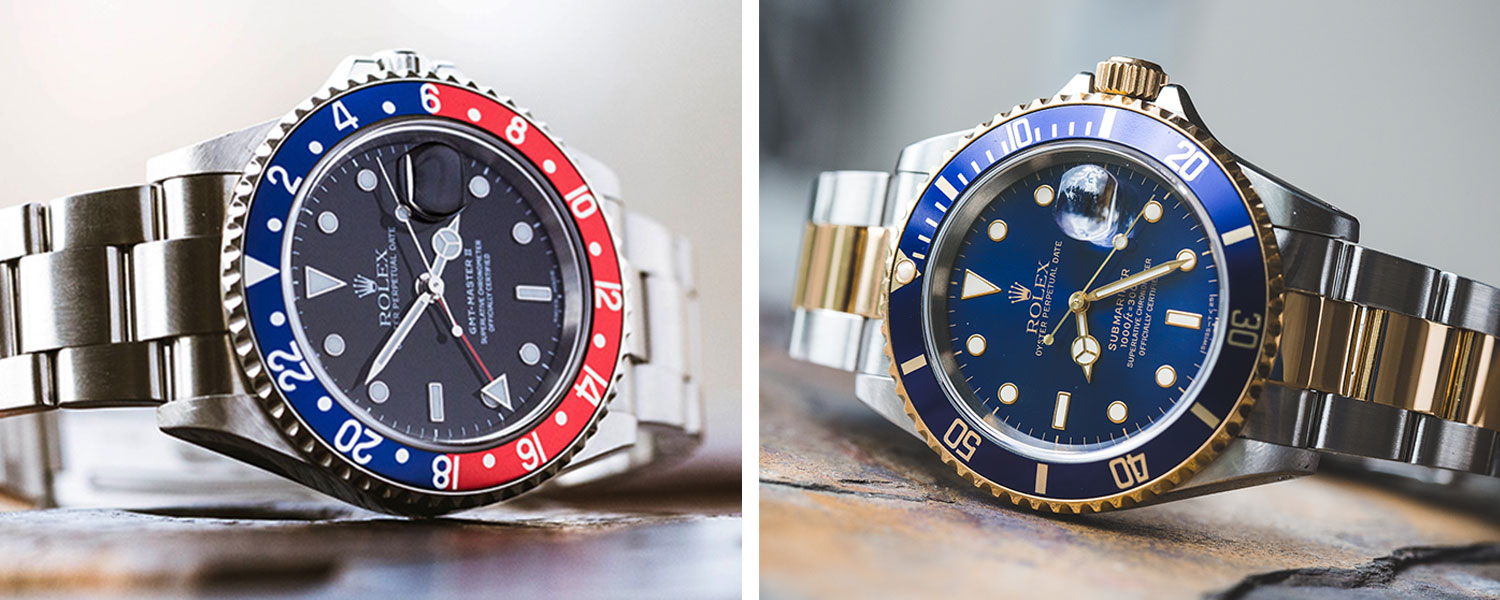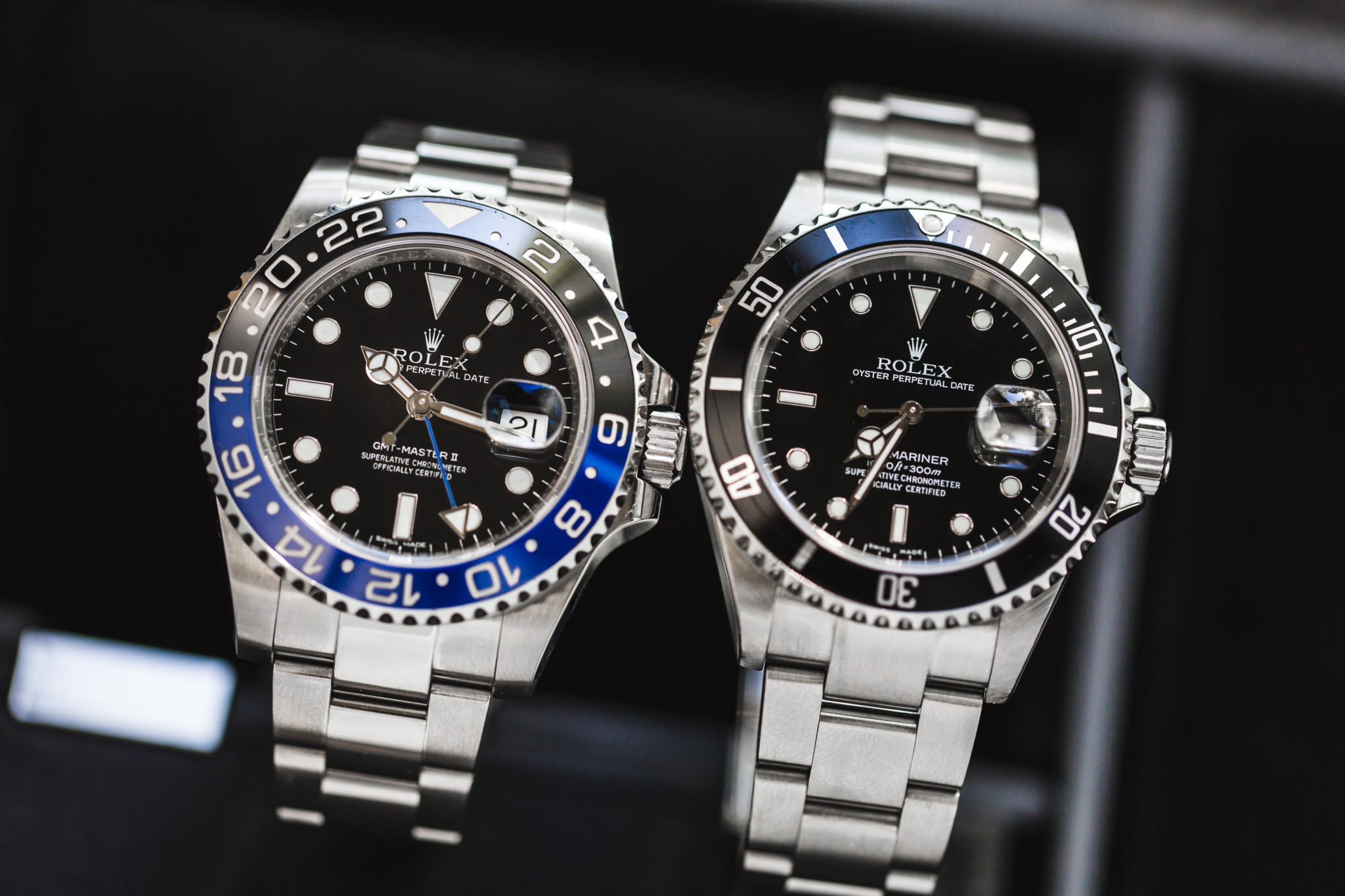

Rolex has pioneered the development of tool watches since its early years, specifically within the fields of diving and flying. When intercontinental travel became more accessible and widespread, Rolex created the GMT Master for pilots flying through multiple time zones. A year prior, Rolex had engineered the Submariner during the worldwide popularization of sea exploration and diving.
The original GMT Master and Submariner debuted in the early 1950s. Since then, both models have become icons and staples of the Rolex brand. They serve as both functional tool watches and fashionable watches for everyday wear. However, in the 1980s, Rolex made a significant update to the GMT Master, and the GMT Master II was born. Here, we have a side-by-side comparison between the Rolex GMT Master II and the Submariner.


Bracelet: The GMT Master II features Rolex’s standard Oyster bracelet, and the Submariner features Rolex’s Glidelock extension system.
Rolex released the first Submariner models in 1953 with the Reference 6204, and soon after, Reference 6205. It was a less-sporty dive watch, which quickly set it apart from its other counterparts. It still maintained the dive watch’s key features, like 100 meters of water resistance, luminous markers, and unidirectional rotating bezel. However, Rolex designed it with a dressier aesthetic that could more seamlessly transition from sea to land.
Part of the charm of the Submariner is in its design, which has only seen minor updates since its inception. In the early 1960s, the Reference 5512 introduced two new key features of the Rolex Submariner: an oversized crown and crown guards. Both of these key features of the Rolex Submariner continue to come standard on the model. In the late 1960s, the Reference 1680 helped to solidify the Submariner as both a dress watch and tool watch. It incorporated the addition of two more key features of the Rolex Submariner: a date function and cyclops magnifier.
Rolex launched the original GMT Master around the same time as the Submariner. However, the GMT Master II didn’t debut until 1983 with the Reference 16760. There are several key features of the Rolex GMT Master II that set it apart. It showcases a 24-hour hand that allows the wearer to read three different time zones. It also contains a brand new movement with an independent quickset hour hand that adjusts to the local time without disrupting the second hand, minute hand, or 24-hour GMT hand. Finally, the GMT Master II is equipped with an extra thick case and large crown guards. These give the model its affectionate nickname, the “Fat Lady.”
Over the years, Rolex has continued to modify the design of the GMT Master II with additional key features. They released the slimmer Reference 16710 just five years after the original model. Then, in 2007, the GMT Master II received a complete redesign with the Reference 116710. Its key features include a Triplock crown, anti-reflective cyclops lens, and green 24-hour hand. It also has a maxi dial, ceramic bezel, new bracelet and movement, and Rolex engraving on the inner bezel ring.
Now, let’s look at a side-by-side comparison of the Submariner and GMT Master II. Historically, these two models have been quite different watches. However, as the Submariner has received a few modern updates and the GMT Master II has evolved, they’ve become more and more similar. For example, two of the latest models, the Submariner Reference 116610 and the GMT Master II Reference 116710, share more common features than ever before.
Both models feature a 40mm “super case.” This “super case” has thicker lugs and crown guards. In addition, both models have a Triplock winding crown. This feature has been standard on Submariner models for years, but it’s a new addition to the GMT Master II. Finally, both models showcase a 904L Oystersteel construction with 48-hour power reserves.
Despite the similarities, there are still a few key differences when you look at a side-by-side comparison of the Submariner and GMT Master II. Each watch has a unique bezel design. The Submariner features a dive watch bezel with 60-minute scale for use as a dive timer. Alternatively, the GMT Master II features a 24-hour scale for use in conjunction with the GMT hand. The next key difference is the watch hands. The Submariner is a standard three-hand watch displaying hours, minutes, and seconds. Instead, the GMT Master II has a fourth, 24-hour GMT hand to display the additional time zone.
The most significant difference between the two models is the movement. The Submariner Ref. 116610 houses the brand’s venerable Caliber 3135 movement. The 3135 has been a mainstay of the brand since 1988. It’s a standard three-hand, automatic movement. On the other hand, the GMT Master II Ref. 116710 is fitted with the brand’s Caliber 3186 movement. The last two key differences between the Submariner and the GMT Master II are more subtle. Modern iterations of the Submariner feature a higher depth rating of up to 300 meters as opposed to the GMT Master II’s standard 100 meters. Lastly, while both models feature Rolex’s iconic Oyster bracelet, the Submariner’s comes equipped with the brand’s Glidelock extension system. This is particularly handy for divers who need to slip the watch over a wetsuit.
Since their inception, the Submariner and GMT Master II have appealed to two distinct groups of wearers. However, the design of the more recent GMT Master II models more closely mirrors the longstanding design of the Submariner. Now, the two models are more aesthetically similar than ever before. If you look at a side-by-side comparison of the GMT Master II and Submariner, it comes down to functional differences.
Protect What You Love With Hodinkee Insurance We're here to help avoid a potential heartache.…
Watching Movies: Adam Driver Takes Over The Gucci Family Empire Wearing A JLC Reverso in…
Second Opinions: The Tudor Black Bay Fifty-Eight Is Not A Submariner Alternative It's its own…
Your Watch Just Tripled In Value – Now What? Auction season is around the corner.…
A Week On The Wrist: The 40mm TAG Heuer Aquaracer Could Be Your Only Watch…
Five Critical Things To Do Before Buying A Watch Online Originally published by Hodinkee, March…